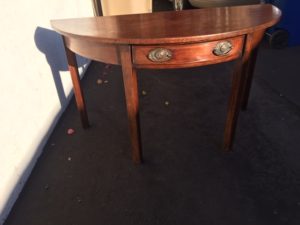 JE owns a fine British Hepplewhite Demi Lune table she picked up for a song at Goodwill before the Pandemic. She threw it in her storage, and now took the time to think about it. The photo came with her many questions. What is it? How old? Should she refinish? What did people originally use it for?
JE owns a fine British Hepplewhite Demi Lune table she picked up for a song at Goodwill before the Pandemic. She threw it in her storage, and now took the time to think about it. The photo came with her many questions. What is it? How old? Should she refinish? What did people originally use it for?
This table served as an extension to a dining table. Hard to conceive, but I’ll tell you how I know. The table is a little less than 28 inches tall, about the height of dining tables. Over the years, because of its age (1810), it lost about three-quarter of an inch from wood wearing away at the bottom. It came as part of a dining suite.
Not a Game Table
Don’t confuse this with the other typical form of demi lune table of that period, the game table. This table usually stood about 30 inches tall, and typically sat four players when the top flipped open and a gate leg swung around. JE’s table stands at dining height, and I don’t see evidence of hinging on the long side and no evidence of a swing leg.
This little semicircle a dining table? Yes, it came as part of a dining table, and a very inventive part. We have not seen this form in a dining room since about 1825.
How They Configured the Suite
Imagine the center table as a rectangular drop leaf table of walnut or mahogany. When not in use, the leaves flopped down, and the table drawn to the wall, as well as demi lune tables. The host had many choices of ways to use the whole set, consisting of one drop leaf table and two similarly sized demi lune tables. For a large group of diners the drop leaf table extended, anchored at either end by the two demi lunes, creating a table over eight feet long.
Table suites like this in the Federal Period in America and the Hepplewhite Period in Great Britain appeared beautiful, practical, and moveable. The host figured the lay-out of the three pieces for specific guests. Serving four to six people, use the drop leaf table only. For six to eight people, leave the drop leaves down and add both demi lune tables at either end. For eight to twelve people, open the drop leaf and add both demi lune tables.
Why did this style go away?
Dining habits changed the dining room in about 1840. A fashion occurred for stately looking dining tables set permanently in the middle of a dining room with chairs. So dining tables “walked’ to the center of dining rooms and stayed there ever since. Except for the year 2020, when the Pandemic forced us to redo our dining rooms into our home offices. Yet again, dining tables are against the walls as in the 15th to 18th centuries.
George Hepplewhite
How do I know it’s Hepplewhite, a style named after a cabinetmaker in London in the late 18th century? Because of the square simple, slightly tapering legs, and the “lion mask” hardware, which are the original pulls to the small drawer, also very practical if the host used the demi lune tables as sideboards.
These lion masks are a feature of the Hepplewhite and Federal Period, but usually in America we see the lion’s mouth holding the bail handle. So, I believe it’s British, about 1804-1810.
Now, should JE strip? I say the value is such ($700) that if she didn’t mind losing the value, she COULD, but I would French Polish the piece, as we see she did in the photo. She took exceptionally light sandpaper and just skimmed the surface of the finish, enough to give 100 percent beeswax something to adhere to. Then she put on about three coats with her bare hands, the warmth helped the table accept the wax. She took three pairs of wool socks and buffed the piece with the socks. This is my recipe for French Polishing, and of course, polish the brasses, as originally, they appeared very bright.
Wow, what a great suggestion regarding the French Polishing details. I have two Hepplewhite desks I picked up about 10 years ago for a total of $300. They’ve been used and of course were bought with nicks here and there but I have oiled them regularly using a Wertzer lemon oil. I will take photos to upload and get an appraisal, since I have no idea what they are worth.
Many thanks, m.